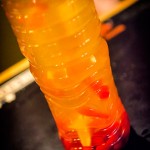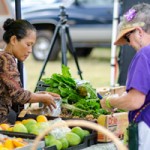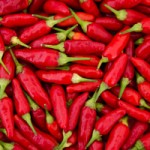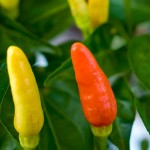The Hottest Crop On Kaua‘i
Mariano Aranda and his family farm two properties, including one-acre at Kilohana Plantation and a small garden at Grove Farm in Koloa. Mariano’s daughter Josie sells their produce, as well as fruit and vegetables from family and friends, at the farmers market.
What’s growing now: Apple bananas, beets, avocado, bitter melon, eggplant, green beans, lettuce, lima beans, long beans, nioi, okra, papaya, pak choi, peanuts, shishito (small, sweet Japanese green pepper), squash, sweet potatoes, tomatoes (heirloom and cherry), winter melon.
HAWAIIAN CHILI PEPPER
Bird peppers, such as the popular “Hawaiian” chili pepper, are classified as C. annuum L. var. glabriusculum. The fruit is yellow and turns red when ripe. In Hawaii, they’re called nioi, or nioi pepa, and can be found in many islands in the Pacific region and in Asia.
Hawaiian chili peppers are very pungent, and can be used in meat dishes, salad dressing, mayonnaise, dairy products, beverages, candies, baked goods, salsa and hot sauce.
Season: Peppers are warm-season crops that are sensitive to climatic conditions during blossom development and fruiting. On Kaua’i, Hawaiian chili peppers are available year-round.
What to look for: Look for uniformity of shape, size and color. The skin should have a glossy appearance and be firm and free of soil or debris. Pods should be bright red, slender (about an inch long), with stems intact. They should be firm, not wrinkled, and free of soft, black spots.
Storage: Fresh Hawaiian chili peppers can be stored in the refrigerator for up to a week before they start to get mushy. In times of abundance, people have had success freezing them, and others prefer to dry them.
Preparation: “Chili pepper water,” which is consumed as a condiment with rice, eggs, fried foods and cocktails, is among the most popular uses for bird peppers in Hawaii. Bird peppers also may be combined with other milder but flavorful chili peppers to create a nuanced flavor profile in dishes.
The green fruit can be used for pickling, while the ripened red fruit can be dried for use as seasoning in soup, stew, sausage, as well as in a host of Asian and Pacific dishes.
For a spicy taco topper, wrap a small handful of Hawaiian chili peppers in tinfoil with a bunch of baby carrots, three cloves of garlic, a sweet onion cut into eighths, five plum tomatoes, and drizzle with olive oil. Roast at 350 degrees, until caramelized, about 30 minutes. Blend and season with a teaspoon of Hawaiian sea salt.
Tip: “People use the leaves when they cook fish,” says Greene. “You can also put the leaves in soup.”
Health benefits: Chili peppers are a rich source of vitamins C and A. Capsaicin, the compound responsible for the pungency
in peppers, is used to relieve pain from arthritis and migraines, and as a cough suppressant, decongestant, and has been shown to have anti-clotting properties.
Mariano Farm produce can be found at: Farmers Markets: Kukui Grove (Mondays at 3 p.m.), Koloa Sunshine Market (Mondays at noon), Kaua’i Culinary Market (Wednesdays at 3:30 p.m.) and Kaua’i Community Market (Saturdays at 9:30).
THE PIG’S FIRE WATER
We fondly call The Feral Pig in Nawiliwili “The Pig” for short. It’s the perfect name for a restaurant that serves dishes made with hogs from Kaneshiro Farm that include house-smoked kalua pig, house-cured bacon and, if you’re lucky, pork fries! The Pig has some of the best chili pepper water on Kaua’i, and Barb Kaawai, who is usually in the kitchen, kindly shares her recipe.
* 14 ounces water
* 1 clove garlic
* 20 Hawaiian chili peppers
* 1 tablespoon salt
Put everything in a bottle, give it a good shake and store in a cool, dark place. This is best if allowed to sit for a month before use.
Marta Lane is a Kaua’i-based food writer. For more information, visit TastingKauai.com.
- Chili pepper water from The Feral Pig in Nawiliwili
- Josie Green on the family farm in Koloa. Daniel Lane photos
- Josie Green sells produce at the Kaua’i Community Market in Puhi
- Red, ripened Hawaiian chili peppers are small but powerful
- Red, ripened Hawaiian chili peppers are small but powerful








